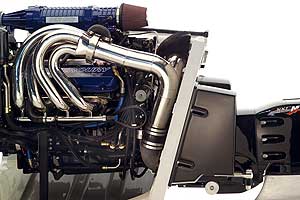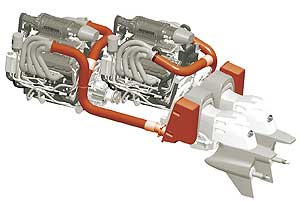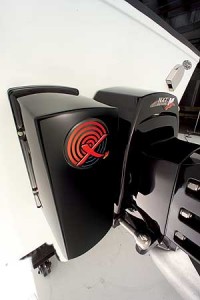Mercury X-haust System Delivers Stealthy Performance
New high-performance exhaust system for 600-plus-horsepower engine meets tough European Union noise-emission standards.

This side-view cut-away of the Mercury Racing X-haust system shows the 4-inch exhaust Y-tube connecting to an elbow fitting passing through the transom below the waterline. The muffler is the black box mounted on the outside of the transom. The smaller, stainless steel exhaust relief outlet is located above the muffler.
If you think noise-emission standards are stringent in the United States, you need to check out those of Europe—we're talking tight. With the new X-haust system for its EU662 engine, Mercury Racing (www.mercuryracing.com) has come up with a solution, and it likely will find its way into the domestic engine market.
There's no question that in recent years the public has become less tolerant of exhaust noise, whether the source is an automobile, a motorcycle, or a high-performance powerboat. The bark of high-compression exhaust used to be part of the fun of a go-fast boat. Now that bark might earn you a ticket, as more law enforcement agencies are clamping down on noisy boats.
Mercury Racing, the proud source of much of the high-performance thunder in the world, has developed a system that can virtually eliminate exhaust noise while preserving the performance of two of its most-popular high-performance engines. X-haust, as the system is called, was designed specifically to comply with the tough European Union (EU) Recreational Craft Directive (RCU) that combines strict exhaust noise and emissions regulations for new boats sold in EU countries.
The Mercury Racing EU662 SCi engine meets the emissions regulations, and with X-haust in place, Merc Racing says boats powered by that engine can pass the noise rules. The RCU noise test requires that a boat not exceed 78 dB-A at a distance of 25 meters (82 feet) when travelling at 70 kph (43.5 mph). Merc says, as a point of reference, the ambient noise level at the waterfront - just the sound of waves lapping the shore — is typically 75 to 80 dB-A. So to pass this test, a boat has to be very quiet.
Fitted with X-haust, a Baja Outlaw 35 with twin EU662 SCi engine packages registered 75 dB-A in the EU RCD pass-by test, with minimal loss of performance, according to Mercury Racing. With a traditional open exhaust system, the same boat would exceed 90 dB-A in the same situation, according to a Merc engineer I talked to. Obviously, there's an application for this sound-limiting technology in the United States, and Mercury Racing will offer two versions (quiet Stage 1 and really quiet Stage 2) X-haust for its HP600 SCi and HP700 SCi engines in single, dual and staggered installations, when rigged with ITS Bravo One XR or NXT1 drives.

This illustration depicts the Mercury Racing Stage 2 X-haust system (in red) installed on staggered engines.
Both the Stage 1 and Stage 2 X-haust utilize a four-inch diameter Y-pipe that collects the exhaust from both engine headers, and routes it to a single through-transom outlet that is located below the waterline when the boat is off plane and just above when the boat is running. There is a 1.5-inch diameter exhaust relief, or by-pass, that routes some exhaust from the four-inch pipe to an outlet that can be located above the waterline on the transom or on the hull side. This relief passage provides a vacuum break to keep water from being sucked into the engine, and reduces back pressure for easier starts and for better performance at full throttle. In the Stage 1 set-up, a 90-degree exhaust outlet, aimed down to direct sound pressure into the water and spray behind the boat, would finish the system. This low-mounted, single exhaust outlet and elbow is enough to reduce sound levels from the low-90 dB-A to the low-80 dB-A range, according to Mercury Racing, and should satisfy most domestic noise ordinances.

This cast-aluminum muffler, mounted on the transom, completes the Stage 2 X-haust system. The cover is finished with the Mercury Sea Core anti-corrosion process. The stainless steel exhaust relief outlet can be seen in the upper corner of the transom.
For ultimate stealth, and to meet the EU regulation, the Stage 2 version of X-haust adds a muffler that looks like a black mail box (7.25 inches wide by 21 tall along the transom, nine inches deep at the top and 13 deep at the
bottom) attached to the transom. In a side-by-side installation, the mufflers would fit between the drives; with staggered engines they would be installed outboard of the drives. The one-piece, cast-aluminum muffler has two chambers connected by three tubes that help "tune" the muffler to cancel certain noise frequencies. The first chamber, closest to the boat, has a slot in the bottom to drain water from the exhaust. The exhaust then escapes from the second chamber through a passage in the bottom that is angled to aim sound pressure down to towards the boat.
Mercury says that the mufflers produce no more than 5 psi backpressure, and that while they can't claim the X-haust system has no effect on engine performance, they will say that effect is so minimal it will not impact boat performance.
Mercury Racing is still pricing the X-haust system for OEM sales to boat builders, but it would replace a number of the components used on a standard dual-exhaust system. Merc says X-haust could retrofit on boats with the HP600 or HP700 engines as long as the boat also has ITS Bravo One XR or NXT1 drives — X-haust will interfere with the steering system of other drives.
At the Miami boat show, I got a ride in a Baja 35 Outlaw with dual HP700 SCi engines and the Stage 2 X-haust system in place. On start-up, these big supercharged, 502-cid engines were as quiet as a four-stroke outboard, even with the engine hatch raised. Buttoned up and idling out of the marina, the only engine sound I could detect was the slight whine of the superchargers. Once on plane, the sound of wind and water overwhelmed any engine sound until about 4000 rpm, when the superchargers really started to howl. This is a 100-mph boat with these engines, and while we didn't have room to reach that speed, we zipped into the low 90s with no problem. What's funny is that, without the roar of the engines, I lost much of the sensation of speed. Aboard a high-performance boat the aural impact of those big engines is an element of the experience.
When it's been cancelled out, the entire experience changes. Maybe Merc should offer an MP3 download of engine noise along with X-haust, just so we remember what fast used to sound like.
Editor's Note: Charles Plueddeman, author Boats.com's outboard expert and personal watercraft expert columns, is the editor at large for Boating, the nation's largest recreational boating magazine.












